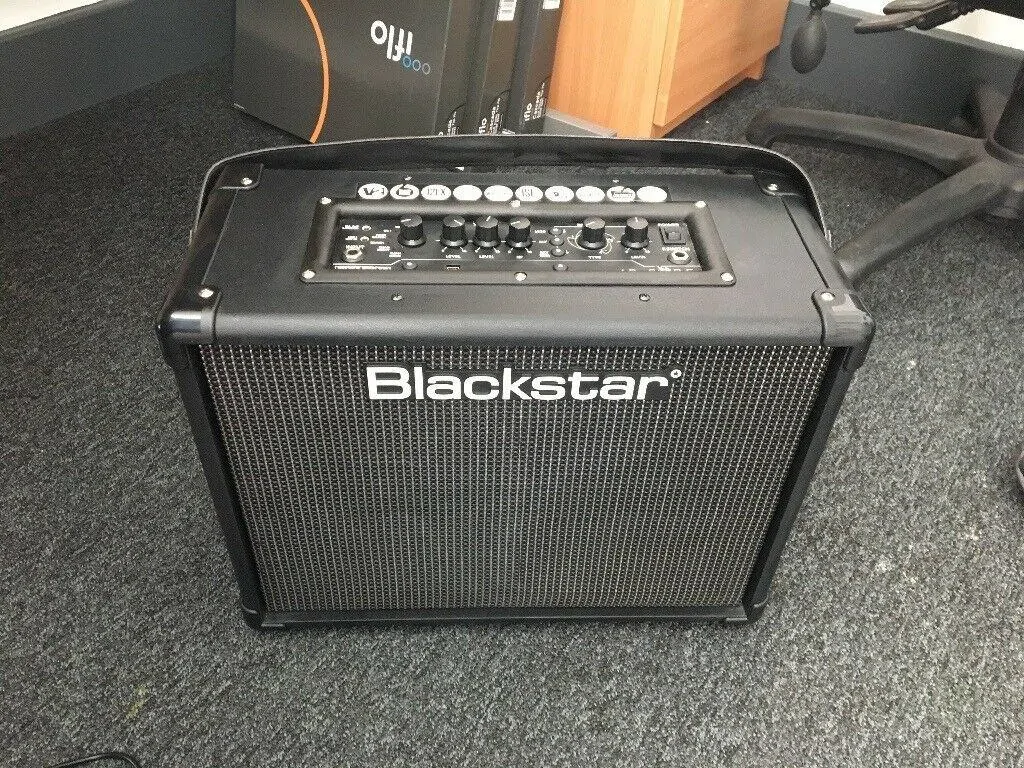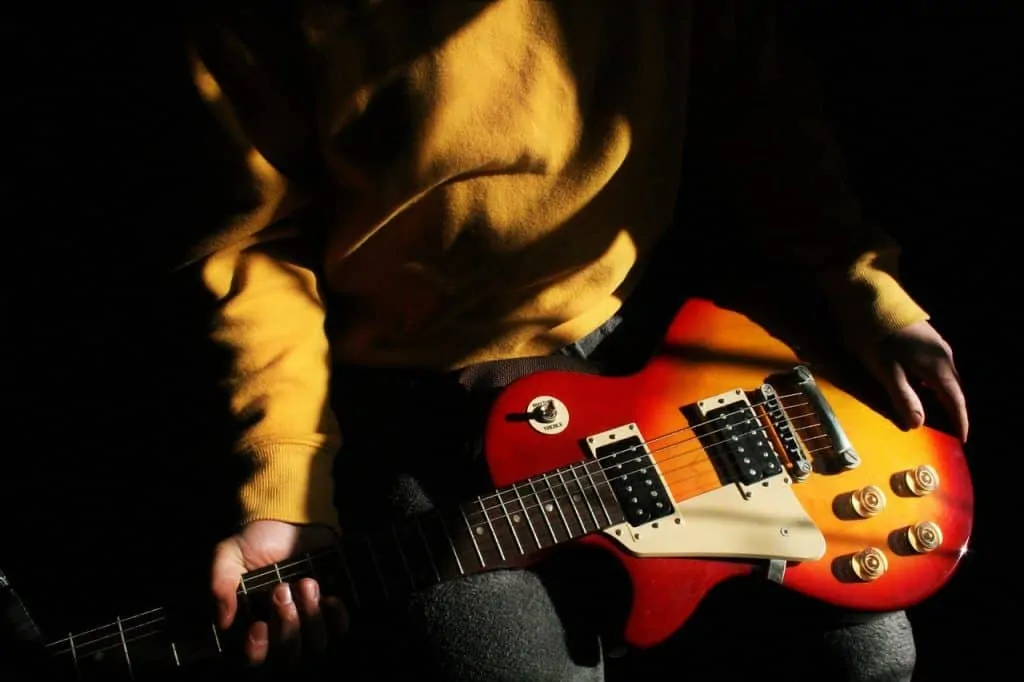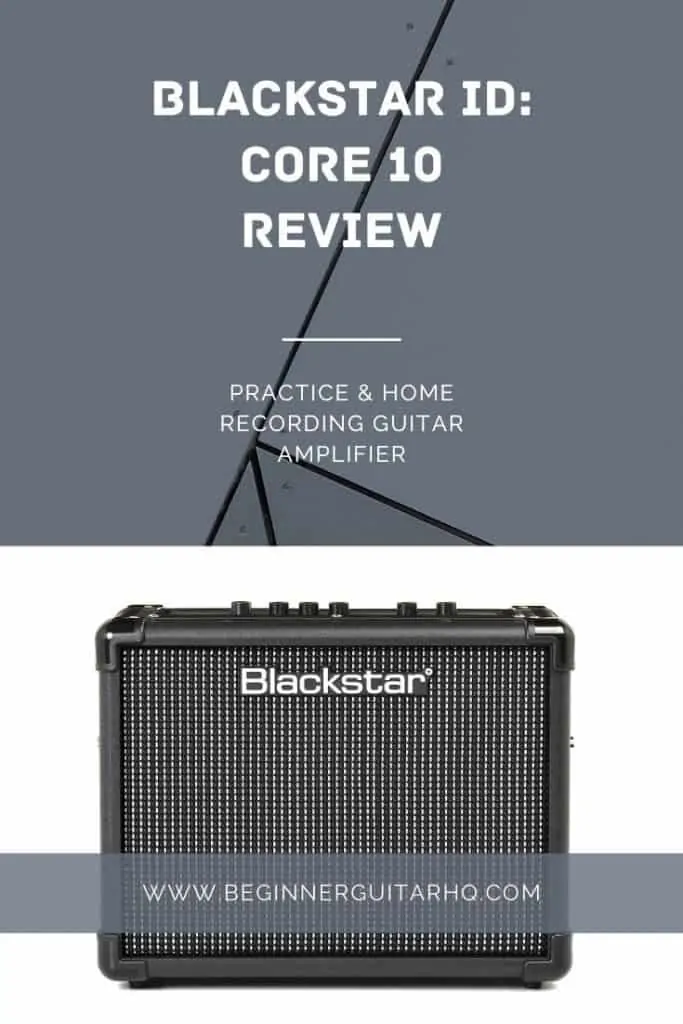When reviewing the best solid-state amps for electric guitar, we’ve always mentioned the ID: Core series. Now, we’ve got the smallest entry of the lineup, the Blackstar ID: Core 10 watts.
Blackstar Amplification is a UK enterprise. Their amplifiers come with wide tonal ranges to help you “find the sound in your head.”
In music-industry terms, Blackstar is a relatively recent company. A group of bandmates and guitar amp techs got together in 2004 to create a new set of cabinets. The idea was delivering highly expressive and flexible tools.
The ID: Core Series is a testament to their mission. More so, the Blackstar ID: Core 10 V2 pushes the envelope on what a budget and small-wattage guitar amp can deliver.
As we’re talking about a feature-rich amplifier, the following review also works as a guide. Bear in mind that this is not an amp for beginners, even if the price suggests “newcomers.” Its many features may feel overwhelming for any musician without some knowledge about effects or guitar recording.
“Blackstar ID Core 40 V2” by Morriscollege420 / CC BY-SA 4.0 The highlight of the ID: Core series is its stereo mix. The stereo sound also comes with a full suite of features for either the stage or the studio.
The Blackstar ID: Core 10 is a combo guitar amplifier. That means it packs the cabinet and the head in the same enclosure.
That said, we’ve reviewed other mini-amps on the site. You can also check the Fender Mustang I or the Vox AC4.
The Vox AC4 is a tubular guitar amplifier, whereas the ID: Core is an all-digital model. Here’re the differences between tube and solid-state amps.
Contents
Blackstar ID: Core Stereo 10 V2 Guitar Combo Modelling Amplifier Review
Blackstar’s ID: Core Stereo 10 is a compact, versatile practice amplifier. We would also call it “mini-amp,” as in an item you would use for practice or home studio recording.
Much like the rest of the amps in the series, it comes with various effects and features. Moreover, it carries a software that enables users to record their guitar on a PC; and create your own sound presets.
One of the most exciting features of the amplifier is its stereo sound. That means the amp creates the sound with left and right speakers.
Another impactful feature is its EQ section, which Blackstar calls “ISF,” a tone signature control. It allows you to toggle from “American” to “British” tones.
The ISF loses standard tonal shaping controls, as there are no “High – Mid – Low” knobs. That’s not to say the mini-amp falls short on options, though, for it’s quite the contrary. Also, I should note the ISF tones sound great in their own terms.
Lastly, the Aux-In headphone line treats your guitar’s signal differently. It makes the instrument sound more vibrant, organic, and resonant. Simultaneously, the headphone output allows you to record the amplifier while listening to the amp’s exact tone.
Overview
Its entry-level price doesn’t mean it comes barebones. The Stereo 10 V2 explains how far Blackstar takes in design to deliver supreme home tools.
Because of that, we’re looking at the most versatile budget amp you can buy. Moreover, it’s among the best sounding digital models in the market. Still, you wouldn’t take a 10 watts amp to play live.
We’re looking at an amplifier with two 5 watts speakers, selling for a budget price. What makes it ideal for home practice and recording is its flexible tone with intuitive controls.
This amplifier packs a proprietary “Super Wide Stereo” sound to deliver immersive playing experiences. On top of that, it has the ISF switch, six different amp voices, and 12 stereo guitar effects to play with.
Overall, the ID: Core 10 combines innovation with an intuitive control set. The result is a versatile amp you can program and set to your liking.
Here’s everything the amp brings:
- 2 x 5W stereo speakers
- Patented ISF EQ
- 6 channels
- 12 stereo effects
- Bank for 6 custom sounds
- Free Insider GUI software
- Direct USB recording
- Stereo MP3/Line In
- Emulated Line Out for silent practice
- AC adapter and USB Type-C cable included
- Built-in tuner
- Included PreSonus Studio One Blackstar Edition DAW
ID: Core 10 V2 Features
The ID: Core V2 comes after nine years of improving the first model of the series. Compared with the original version, the follow-up model ships with more voices, better-sounding speakers, and extra effects.
Let’s break down its features:
ISF knob
The ISF is the core element of the amplifier. It allows you to swap between two recognizable tone signatures.
First, you can go to the left marker, which adds American characteristics to the guitar. That means a focused bottom end, aggressive middles, and subdued highs.
The second option is going to the right marker, clockwise. It adds the “British” tone, which means dirty, “woody,” and not as aggressive.
There’re also some markers in between, which mix the two tonal signatures in different degrees.
Blackstar intends for its patented ISF control to give you the precise tonal signatures you’re craving.
Voices
Then, the V2 comes with six different voices through its Voices knob. You would know them as channels, and these work alongside the ISF toggle.
These channels are as follows:
- Clean: the regular clean sound of your guitar, with no extra coloring in the mix
- Clean bright: a different kind of clean that adds brightness and a light saturation to your guitar.
- Crunch: it delivers a minor distortion.
- Super Crunch: it starts sounding more aggressive and distorted at the mids, without losing too much information. It gets close to metal territory.
- OD 1: it distorts the guitar for those sweet riffs.
- OD 2: it’s the heaviest distortion. However, the amp starts losing information when you push the gain knob past the middle.
Alongside the ISF knob, the different voices can give you the exact tone you’re imagining. These two options turn the ID: Core into a modeling solid-state amp.
Super Wide Stereo
The ID: Series comes with the brand’s stereo technology. That means the amp delivers its 10 watts of sound divided into two 5 watts sections.
The stereo sound improves the output quality, resonance, and power of the signal. The tone it delivers creates a minor surround effect.
Here’s a demo of the Super Wide Stereo sound:
Stereo effects
Like so, the amp comes with 12 stereo effects built to sound like analog guitar pedals.
These effects are modulation, reverb, and delay. On top of that, each effect comes with four options, and you would need to toggle the “Effects Type” knob to toggle between the different effect types.
Within the options, you’d find, for example, a phaser, a flanger, a spring reverb, and a chorus. However, the amplifier doesn’t indicate which specific effect you’re using, so you’d need to get familiar with the cabinet before moving forward.
Here’s the full list of effects:
- Modulation: phaser, chorus/flanger, envelope, tremolo.
- Delay: linear, analog, tape, multi
- Reverb: room, hall, spring, plateau.
You can read the full info on the amp’s manual.
Insider Software
Blackstar also adds a software suite as part of the amp’s bundle. The software allows you to record music, as well as play around with the amp’s tone.
You can connect the amplifier to your computer through a USB 2.0 port and go out from a USB Type-C cable at the amp’s top (cable included).
The software allows you to edit effects and store them as “patches” on the Blackstar. You save these patches as part of a “voice.” They pack an edited effect within that voice. You can also share these patches online and download any other from the Blackstar community.
Also, the software enables you to record audio from your amplifier. That means you could use the amplifier as an audio interface: connect the guitar to the amp and the amp to the computer via a USB cable.
The USB connector allows re-amping and recording. Plus, it enables you to record the preamp section of the amplifier alone, so you can add effects and cabinet emulations via your DAW, post-processing, or VST plugins.
The program works on both Mac and Windows. You need to download it from Blackstar’s website. While it’s free, it only works with the ID: Core series.
Insider is not a DAW, a VST, or a “sound generator.” It’s merely a GUI for the ID: Series amps (Graphical User Interface).
Here’s a showcase of the software:
Re-amping mode
You can select the “Reamping Mode” via the GUI. It’s the option that allows you to record your guitar’s dry signal into the computer.
Moreover, it allows the amp to catch the dry signal and process it with its own effects.
Direct USB recording
I should note that you don’t need any extra drivers to use the amplifier with your computer.
You can simply open up the GUI to modify the sound and then open any DAW like FL Studio to press record.
The amplifier appears on your PC as an audio capture device. You would see it on your recording program of choice.
More interestingly, the audio output coming from the amp comes on four separate channels:
- Channel 1: left cabinet emulation
- Channel 2: right cabinet emulation
- Channel 3: preamp output, which contains the Voice and the EQ
- Channel 4: dry signal.
You can record all of these channels at the same time from your DAW. You may pan Chanel 1 all the way to the left and Channel 2 100% to the right for a full stereo mix.
At the same time, the ID: Core amp receives audio from your recording computer. You may connect a headphone to the MP3 Line/In to monitor your sound.
I should note that the ID: Core 10 includes a DAW software. In particular, it ships with a version of the professional PreSonus software.
The Blackstar ID: Core 10 gives you all of the sound options you’d need for a home recording like an EP, a demo, a practice track, or a backing track. You wouldn’t need extra guitar pedals at that level.
ID: Core 10 V2 Controls
On the far left, you have the voice toggle knob. As we said before, it brings six different amp voices.
To the right, you’ll find the standard volume and gain knobs, going from 0 to 10. Naturally, the “Gain” knob works on the effect’s volume. In contrast, the volume knob raises the overall output of the guitar’s signal.
Next-up, we find the ISF toggle or the EQ knob. It has six different markers to blend the American and British tones if you wish.
Next, there’re three LED lights/buttons indicating which effect you’ve engaged (MOD, Delay, or Reverb). You can simply press these buttons to toggle between the effects.
At the far right, you’ll find the last two knobs on the “Effects” section. There’s a “Type” knob to toggle between the four different effect kinds, and there’s a “Level” knob.
There’s also an MP3/Line In connection at the front. You can plug any kind of aux cable to start playback from a mobile device, computer, or similar. Alternatively, it returns your recording signal.
Lastly, the “Emulator Out” is also a headphone connector that emulates the amp’s stereo qualities. It also works on PA systems or audio mixers.
Furthermore, you can use a 3.5mm-to-two mono jacks splitter head to feed two channels of a mixer or recording device.
Amplifiers with extended features and effects are intended for home or studio use. You wouldn’t feel comfortable playing these devices live, as you’d need time to prepare each sound and effect.
Level knob and “Tap” button
In particular, the “Level” knob modifies the parameter of the effects. It works in conjunction with the “Tap” button below the effects.
You’ll need to hold down the Tap button to modify the effects’ speed or delay time.
As you may know, the time or rate will be equal to the number of seconds you hold the button down.
Here’s the breakdown:
| Tab button | Level knob | |
| Modulation | Speed | Modulation depth |
| Delay | Time | Delay level |
| Reverb | N/A | Reverb level |
Manual mode (sound patches)
There’s a “Manual” button on the bottom left of the top panel. Pressing the button would enable your preset patches. By default, the amp functions just as the knobs say.
You can also store a current effect tweak as a patch with the button:
- Turn off the Manual mode
- Select a voice
- Tweak the effect with the tap button and the level knob
- Press and hold the Manual button until the Voice LED flashes
- Press the Manual mode to turn the patch of the current voice.
You can store six patches (one per voice).
That means the amp will save a preset as part of a Voice. To recall the preset, you can select the same voice and press the Manual button again. Keep an eye on the LED light on the Manual button: it indicates the Patch mode is not online when it’s off.
Naturally, you can recall, edit, and store a preset via the Insider software.
Advanced Controls
The ID: Core features advanced controls for experienced users. You can access these features by pressing more than one button at the same time. In particular, it works with the Tap button as a “Shift Key” to enable alternative options.
- Music Playback Volume: you can press Tap and move the Volume knob to modify your music playback volume on the MP3/Line output.
- USB recording level: press Tap and move the Gain knob to modify the output recording level. It doesn’t change the level of the signal you record, though. It merely allows you to play at a comfortable level, even in silence.
- Tuner mode: you can hold the Reverb switch to engage the built-in tuner. It’s not an easy feature to use, so I understand if most people skip it.
Footswitch
Lastly, you can use a separate Blackstar FS-11 footswitch to further the control over the amp.
The foot controller would toggle between the patches. Moreover, you can select the patches via the Insider software.
Performance
We don’t expect such an amount of extraordinary features on a home amp. That’s why the ID: Core 10 V2 exceeds what most practice amps can do.
Taking all of its features into consideration, we get a great sounding stereo amp with a multitude of sound tweaking. With an included GUI plus DAW, you can start recording your guitar right away.
The output and effect quality is superb and far beyond what the price suggests because of its stereo technology.
With its voices and ISF switch, the ID: Core 10 can play any genre you imagine. Just remember that you can only engage one effect at a time.
It doesn’t have much headroom when playing metal genres. You would need to keep the knobs around the middle, which wouldn’t be a problem for a practice amp.
With the amplifier’s extended characteristics, the Blackstar ID: Core 10 can become an essential asset for practice and home recording.
Drawbacks & alternatives
Overall, there’re no major complaints, which is why my recommendation is gong for a bigger model of the series. The prices are not that different!
Yet, I can point out that you probably won’t like all of its voices. A similar amp with a better built-in voice configuration is the Boss Katana series. Here’s the smallest of the series:
Or you could go for a pro Boss Katana, which is known as the best digital amp in the market:
In Summary
All in all, the Blackstar ID: Core 10 V2 shows how far modeling amps can go. It represents the full potential of all-digital amps. It comes as a compact bundle you would use for practice and budget recordings.
You wouldn’t use it for a serious gig, but you may take a bigger model of the series to a show -simpler amps running on clean plus guitar pedals will always do better.
Yet, the ID: Series amps are a multi-purpose tool for recording studios. These are not amps for beginners, though. Its full suite of options would only mean something for experienced players and those wanting to record their guitars.
On the hands of an experienced player, the ID: Core 10 would worth 10 times its retail value.
Final say
For the price it costs, you can’t go better than this. It’s even one of the cheapest guitar amplifiers on the market, so it’s a no-brainer.




